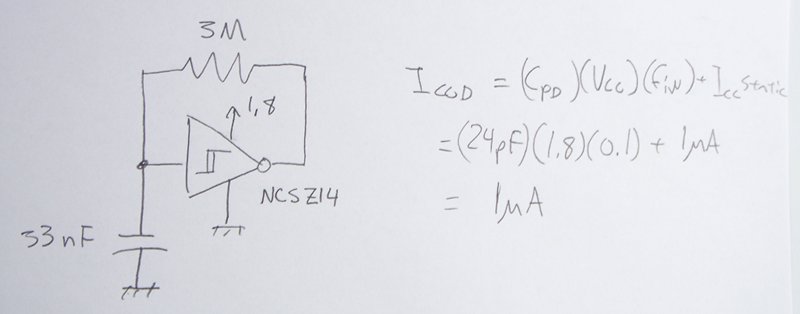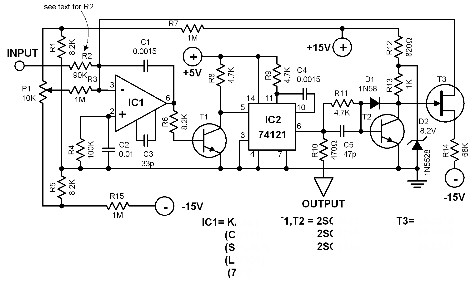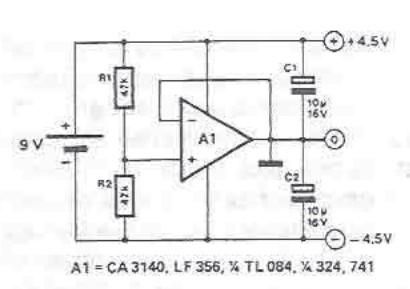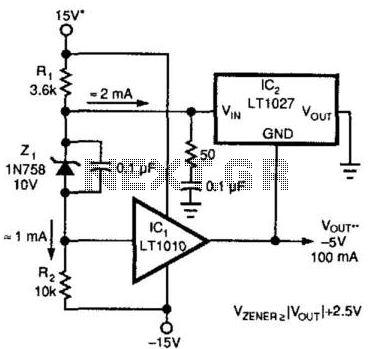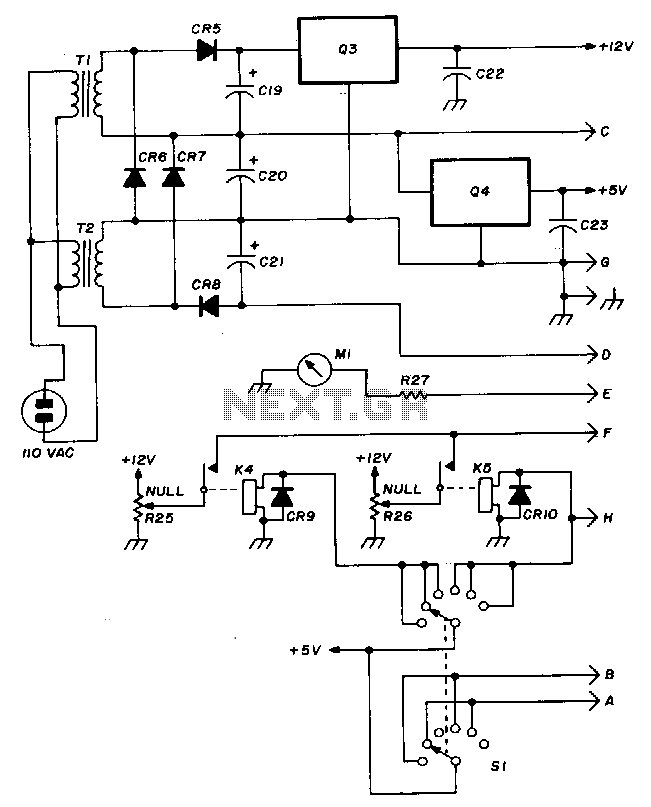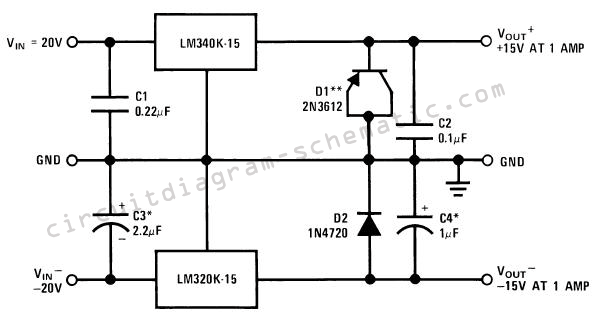
MAX668 inverting configuration quadruple pressure DC DC converter power supply
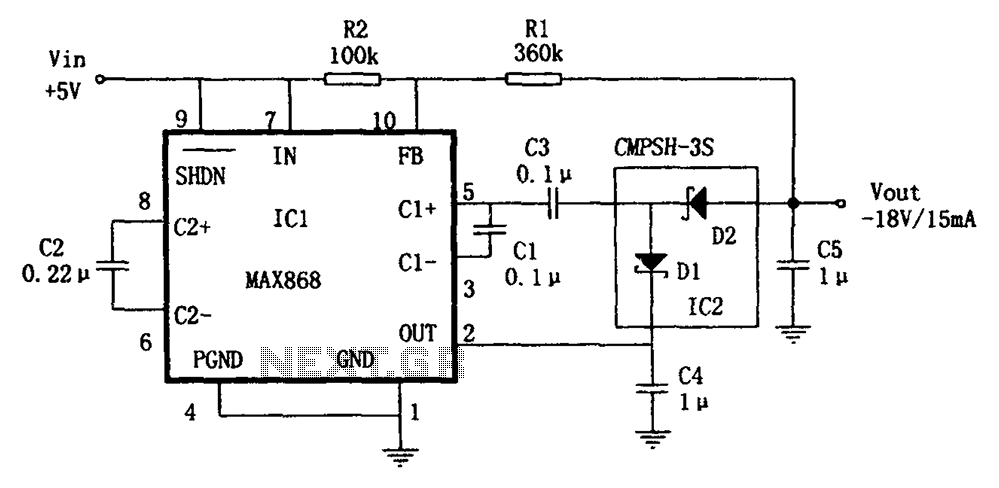
The circuit utilizes the IC1 MAX868 and CMPSH-3S to create a quadruple voltage DC/DC converter power supply. The IC1 MAX868 is an inverting charge pump regulator integrated circuit that can generate an output voltage of up to -2VIN, with an input voltage range of 1.8 to 5.5V. It employs pulse frequency modulation (PFM) to regulate the output voltage, with a maximum frequency of 450 kHz. The circuit features a very low quiescent current of 30 µA. A charge pump is incorporated using capacitors C3 and C4 along with a Schottky diode in the feedback loop, forming a quadruple voltage inverter power supply circuit. The output voltage (VOUT) can reach -18V, providing a current of 15 mA with an efficiency of 76% and a ripple of 60 mV. If VOUT is reduced, higher current outputs can be achieved; for instance, at VOUT -15V, it can supply 20 mA, and at VOUT -12V, it can provide 30 mA. The stability of the output voltage is determined by the feedback resistor R1 and the resistor ratio R2, following the relationship VOUT = -VIN (R1/R2).
The described circuit employs the MAX868 in conjunction with CMPSH-3S to achieve a quadruple voltage output through a DC/DC conversion mechanism. The inverting charge pump configuration is particularly advantageous for applications requiring negative voltage supplies. The input voltage range of 1.8V to 5.5V allows for versatility in various electronic applications, ensuring compatibility with a wide range of power sources.
The pulse frequency modulation technique utilized by the MAX868 is effective in maintaining output voltage regulation while minimizing power loss, as evidenced by the low quiescent current of 30 µA, which contributes to overall energy efficiency. The maximum frequency of 450 kHz allows for rapid response to load variations, ensuring stable output under dynamic conditions.
The integration of capacitors C3 and C4 along with a Schottky diode in the feedback loop is crucial for the charge pump operation, enabling the generation of the desired quadruple voltage. The design allows for a maximum output voltage of -18V, which is suitable for various applications requiring negative voltage levels, such as operational amplifiers or analog signal processing circuits.
The current output capabilities of the circuit are noteworthy; the ability to provide 15 mA at -18V is complemented by the option to achieve higher current outputs at lower voltages, with 20 mA at -15V and 30 mA at -12V. This flexibility allows the circuit to adapt to different load requirements without compromising performance.
The feedback mechanism involving resistors R1 and R2 is fundamental in establishing the output voltage stability. The relationship VOUT = -VIN (R1/R2) ensures that the output voltage can be finely tuned by adjusting the resistor values, thus allowing for precise control over the output characteristics depending on the specific application requirements. Overall, this circuit design exemplifies a robust solution for generating stable negative voltages in compact electronic systems. As shown in FIG inverted to adopt IC1MAX868 and CMPSH-3S consisting of four times the pressure of DC/DC converter power supply. IC1MAX868 which is a type inverting charge pump regulator integrated circuit, can produce up to -2VIN output voltage, input voltage VIN range from 1.8 ~ 5.5V. IC1 through pulse frequency modulation (PFM) to regulate the output voltage, the maximum frequency of 450kHz.
Very low quiescent current (30 A). Insert a charge pump by the C3, C4 and Schottky diode in its feedback loop, to form a quadruple voltage inverter power supply circuit.The power supply at VOUT -18V, can provide current 15mA, efficiency 76%, ripple 60mV. If you reduce VOUT, allows a higher current output, such as when VOUT -15V, can provide 20mA, VOUT -12V when compared to 30mA.
Its stable output voltage by the feedback resistor Rl and R Ratio is determined. That VOUT -VIN (R1/R2).
The described circuit employs the MAX868 in conjunction with CMPSH-3S to achieve a quadruple voltage output through a DC/DC conversion mechanism. The inverting charge pump configuration is particularly advantageous for applications requiring negative voltage supplies. The input voltage range of 1.8V to 5.5V allows for versatility in various electronic applications, ensuring compatibility with a wide range of power sources.
The pulse frequency modulation technique utilized by the MAX868 is effective in maintaining output voltage regulation while minimizing power loss, as evidenced by the low quiescent current of 30 µA, which contributes to overall energy efficiency. The maximum frequency of 450 kHz allows for rapid response to load variations, ensuring stable output under dynamic conditions.
The integration of capacitors C3 and C4 along with a Schottky diode in the feedback loop is crucial for the charge pump operation, enabling the generation of the desired quadruple voltage. The design allows for a maximum output voltage of -18V, which is suitable for various applications requiring negative voltage levels, such as operational amplifiers or analog signal processing circuits.
The current output capabilities of the circuit are noteworthy; the ability to provide 15 mA at -18V is complemented by the option to achieve higher current outputs at lower voltages, with 20 mA at -15V and 30 mA at -12V. This flexibility allows the circuit to adapt to different load requirements without compromising performance.
The feedback mechanism involving resistors R1 and R2 is fundamental in establishing the output voltage stability. The relationship VOUT = -VIN (R1/R2) ensures that the output voltage can be finely tuned by adjusting the resistor values, thus allowing for precise control over the output characteristics depending on the specific application requirements. Overall, this circuit design exemplifies a robust solution for generating stable negative voltages in compact electronic systems. As shown in FIG inverted to adopt IC1MAX868 and CMPSH-3S consisting of four times the pressure of DC/DC converter power supply. IC1MAX868 which is a type inverting charge pump regulator integrated circuit, can produce up to -2VIN output voltage, input voltage VIN range from 1.8 ~ 5.5V. IC1 through pulse frequency modulation (PFM) to regulate the output voltage, the maximum frequency of 450kHz.
Very low quiescent current (30 A). Insert a charge pump by the C3, C4 and Schottky diode in its feedback loop, to form a quadruple voltage inverter power supply circuit.The power supply at VOUT -18V, can provide current 15mA, efficiency 76%, ripple 60mV. If you reduce VOUT, allows a higher current output, such as when VOUT -15V, can provide 20mA, VOUT -12V when compared to 30mA.
Its stable output voltage by the feedback resistor Rl and R Ratio is determined. That VOUT -VIN (R1/R2).
